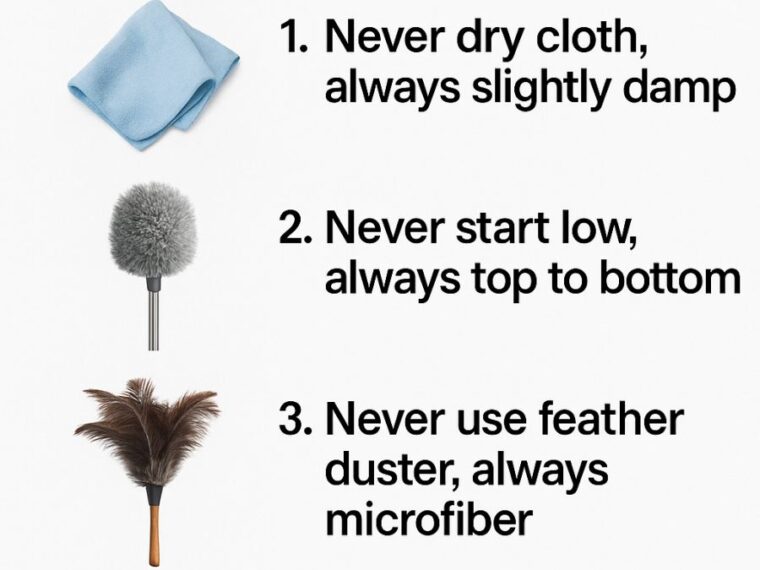Dusting is often considered one of those mundane household chores that many of us rush through without much thought. However, doing it incorrectly can lead to more dust accumulation and potentially even damage to your home’s surfaces. If you find yourself sneezing or coughing more often after a cleaning session, it might be time to rethink your dusting strategy.
Dusting isn’t just about aesthetics; it plays a critical role in maintaining a healthy indoor environment. Dust can harbor allergens, bacteria, and even mold spores, contributing to poor air quality. Therefore, learning the correct techniques for dusting is not only about keeping your home looking pristine but also about safeguarding your health.
1. Start from the Top: The Right Order Matters
One of the most common mistakes people make when dusting is starting from the bottom and working their way up. This is counterproductive because gravity causes dust to fall downward, meaning you’ll have to redust lower surfaces if you start there. Always begin dusting from the highest points in a room, such as ceiling fans, light fixtures, and high shelves, and work your way down.
By using this top-to-bottom approach, you’ll ensure that any dust you dislodge from higher surfaces doesn’t settle on areas you’ve already cleaned. This method is not only efficient but also time-saving, allowing you to complete your dusting tasks more effectively.
2. Why You Should Ditch the Feather Duster for Microfiber
Feather dusters may look quaint and traditional, but they often do more harm than good when it comes to dusting. Rather than trapping dust, they tend to scatter it around, making your efforts futile. Instead, opt for microfiber cloths, which are specifically designed to capture and hold dust particles.
Microfiber cloths are made of tiny fibers that are split during manufacturing, increasing their surface area and creating more ‘hooks’ to grab dust. They are highly effective and can hold up to seven times their weight in dust and dirt. When using a microfiber cloth, lightly mist it with a bit of water or a dusting spray to enhance its dust-attracting capabilities.
3. The Benefits of a Slightly Damp Cloth Over a Dry One
Using a slightly damp cloth can significantly enhance your dusting routine. A dry cloth may simply move the dust around, whereas a damp cloth will capture and hold onto the particles. The key is to ensure the cloth is not too wet, as excess moisture can damage surfaces, especially wood and electronics.
To achieve the right level of dampness, lightly spray the cloth with water or a gentle cleaning solution. The moisture helps to bind dust particles to the cloth, making it easier to pick them up and reduce airborne dust. This method is particularly effective for flat surfaces, such as tables and countertops.
4. Dusting Ceiling Fans and Light Fixtures
Ceiling fans and light fixtures are notorious dust collectors, yet they are often overlooked because of their height. To dust these areas effectively, use an extendable duster with a microfiber head. This allows you to reach high places without the need for a ladder.
For ceiling fans, ensure the blades are stationary and wipe each blade from the center toward the tip to prevent dust from scattering. When it comes to light fixtures, be cautious of delicate bulbs and remove any detachable parts for a thorough clean. Regularly dusting these fixtures not only improves air quality but also enhances light output by removing layers of dust that can dim illumination.
5. Don’t Forget the Vents: Vacuum First
Air vents are another common dust trap that can affect your home’s air quality if not cleaned regularly. Start by vacuuming the vent covers with a brush attachment to remove loose dust. This step is crucial because it prevents dust from being blown back into the room when the HVAC system is running.
After vacuuming, use a damp microfiber cloth to wipe down the vent covers and remove any remaining dust. If the vents are particularly dirty, consider removing them and soaking them in warm, soapy water for a deeper clean. Always ensure the vents are completely dry before reattaching them to prevent mold growth.
6. Tackling Baseboards and Moldings
Baseboards and moldings often accumulate dust, especially in homes with pets or high foot traffic. To dust these areas, begin with a vacuum cleaner equipped with a brush attachment to remove loose dirt and pet hair. This step helps prevent scratching the paint or finish when you wipe them down.
Next, use a microfiber cloth or a dusting mitt lightly dampened with water or a gentle cleaner. Wipe the baseboards and moldings, paying special attention to corners and crevices where dust tends to settle. For stubborn grime, a solution of water and vinegar can be effective in breaking down buildup without damaging the surface.
7. Keeping Electronics Dust-Free
Electronics such as TVs, computers, and gaming consoles are magnets for dust due to static electricity. To properly dust these items, first ensure they are powered off and unplugged for safety. Use a microfiber cloth specifically designed for electronics, or a soft, lint-free cloth. Avoid using paper towels or rough fabrics, which can scratch screens.
For screens, lightly dampen the cloth with water or a screen-safe cleaner. Wipe in gentle, circular motions to avoid streaking. For keyboards and other crevices, use compressed air to blow out trapped dust, followed by a soft brush to remove remaining particles. Regular dusting of electronics not only prolongs their lifespan but also enhances performance by preventing overheating caused by dust accumulation.
8. How to Properly Dust Wooden Furniture
Wooden furniture requires special care to maintain its finish and prevent damage. Begin by dusting with a dry microfiber cloth to remove loose dust. For a deeper clean, use a slightly damp cloth or a dedicated wood cleaner, ensuring you follow the grain of the wood to avoid scratches.
After dusting, consider applying a wood polish to restore the furniture’s shine and add a protective layer against future dust. Use a soft cloth to apply the polish, buffing in circular motions to achieve an even finish. Regular maintenance not only keeps the furniture looking new but also preserves its structural integrity.
9. Managing Bookcases and Shelving Units
Bookcases and shelving units can quickly become cluttered with dust, especially if they house numerous items. To start, remove all items from the shelves and dust each item individually with a microfiber cloth. This ensures that you don’t simply move dust from one spot to another.
Once the items are dusted, wipe down the shelves themselves, using a damp cloth for any stubborn dust or dirt. Pay attention to corners and edges where dust tends to accumulate. After dusting, replace items neatly, perhaps taking the opportunity to reorganize or declutter the space.
10. Cleaning Window Blinds and Curtains
Window blinds and curtains are often neglected in regular cleaning routines, yet they can harbor significant amounts of dust. For blinds, close them fully and use a microfiber cloth or a specialized blind duster to clean each slat. Then, reverse the blinds and dust the other side. For tougher stains, a mild detergent mixed with water can be used.
When it comes to curtains, regular vacuuming with an upholstery attachment can help maintain their appearance. For a deeper clean, check the care label to see if they are machine washable or require dry cleaning. Regular maintenance of blinds and curtains not only improves their appearance but also enhances the overall air quality in the room.
11. Dusting Plants and Decorative Items
Houseplants can accumulate a surprising amount of dust on their leaves, which can hinder their ability to photosynthesize effectively. Use a soft, damp cloth to gently wipe each leaf, supporting the underside with your hand to prevent damage. For smaller plants, a quick rinse under a gentle stream of water can suffice.
Decorative items, such as sculptures or photo frames, should be dusted with a microfiber cloth. For intricate designs, use a small, soft-bristled brush to reach into crevices. Keeping these items dust-free not only enhances their appearance but also contributes to a cleaner and healthier home environment.





